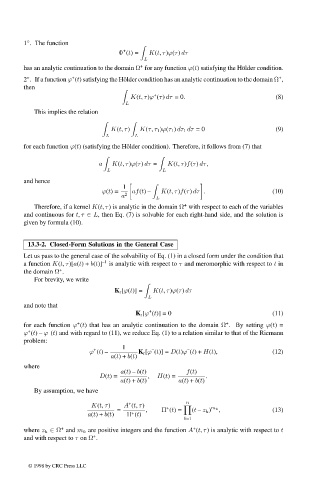Page 664 - Handbook Of Integral Equations
P. 664
◦
1 . The function
+
Φ (t)= K(t, τ)ϕ(τ) dτ
L
+
has an analytic continuation to the domain Ω for any function ϕ(t) satisfying the H¨ older condition.
+
+
2 . If a function ϕ (t) satisfying the H¨ older condition has an analytic continuation to the domain Ω ,
◦
then
+
K(t, τ)ϕ (τ) dτ = 0. (8)
L
This implies the relation
K(t, τ) K(τ, τ 1 )ϕ(τ 1 ) dτ 1 dτ = 0 (9)
L L
for each function ϕ(t) (satisfying the H¨ older condition). Therefore, it follows from (7) that
a K(t, τ)ϕ(τ) dτ = K(t, τ)f(τ) dτ,
L L
and hence
1
ϕ(t)= af(t) – K(t, τ)f(τ) dτ . (10)
a 2 L
+
Therefore, if a kernel K(t, τ) is analytic in the domain Ω with respect to each of the variables
and continuous for t, τ ∈ L, then Eq. (7) is solvable for each right-hand side, and the solution is
given by formula (10).
13.3-2. Closed-Form Solutions in the General Case
Let us pass to the general case of the solvability of Eq. (1) in a closed form under the condition that
a function K(t, τ)[a(t)+ b(t)] –1 is analytic with respect to τ and meromorphic with respect to t in
+
the domain Ω .
For brevity, we write
K r [ϕ(t)] = K(t, τ)ϕ(τ) dτ
L
and note that
+
K r [ϕ (t)] = 0 (11)
+
+
for each function ϕ (t) that has an analytic continuation to the domain Ω . By setting ϕ(t)=
–
+
ϕ (t) – ϕ (t) and with regard to (11), we reduce Eq. (1) to a relation similar to that of the Riemann
problem:
1 – –
+
ϕ (t) – K r [ϕ (t)] = D(t)ϕ (t)+ H(t), (12)
a(t)+ b(t)
where
a(t) – b(t) f(t)
D(t)= , H(t)= .
a(t)+ b(t) a(t)+ b(t)
By assumption, we have
n
+
K(t, τ) A (t, τ) +
= , Π (t)= (t – z k ) m k , (13)
+
a(t)+ b(t) Π (t)
k=1
+
+
where z k ∈ Ω and m k are positive integers and the function A (t, τ) is analytic with respect to t
+
and with respect to τ on Ω .
© 1998 by CRC Press LLC
© 1998 by CRC Press LLC
Page 647

